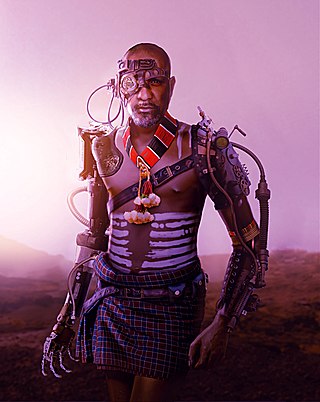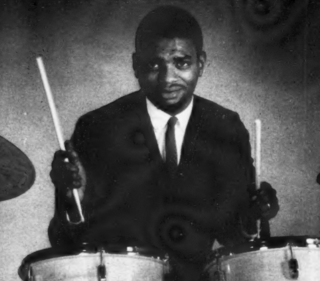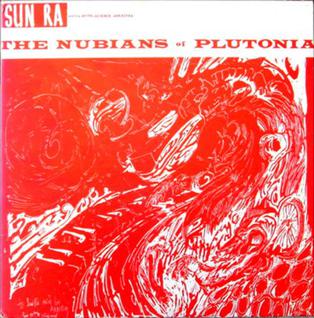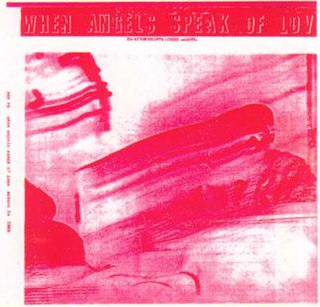
Le Sony'r Ra, better known as Sun Ra, was an American jazz composer, bandleader, piano and synthesizer player, and poet known for his experimental music, "cosmic" philosophy, prolific output, and theatrical performances. For much of his career, Ra led The Arkestra, an ensemble with an ever-changing name and flexible line-up.

Afrofuturism is a cultural aesthetic, philosophy of science, and history that explores the intersection of the African diaspora culture with science and technology. It addresses themes and concerns of the African diaspora through technoculture and speculative fiction, encompassing a range of media and artists with a shared interest in envisioning black futures that stem from Afro-diasporic experiences. While Afrofuturism is most commonly associated with science fiction, it can also encompass other speculative genres such as fantasy, alternate history and magic realism. The term was coined by American cultural critic Mark Dery in 1993 and explored in the late 1990s through conversations led by Alondra Nelson.
Irwin Chusid is a journalist, music historian, radio personality, record producer, and self-described "landmark preservationist". His stated mission has been to "find things on the scrapheap of history that I know don't belong there and salvage them." Those "things" have included such previously overlooked but now-celebrated icons as composer/bandleader/electronic music pioneer Raymond Scott, Space Age Pop avatar Esquivel, illustrator/fine artist Jim Flora, various outsider musicians, and The Langley Schools Music Project. Chusid calls himself "a connoisseur of marginalia," while admitting he's "a terrible barometer of popular taste."

Lex Humphries was an American jazz drummer. He worked with two musicians known for mixing world music with jazz: Sun Ra and Yusef Lateef. As a member of Sun Ra's "Arkestra" he appeared in the film Space Is the Place.

Space Is the Place is a studio album by Sun Ra. It was originally released on the Blue Thumb label in 1973. In 1998, it was reissued by Impulse! Records.

Featuring Pharoah Sanders and Black Harold is a jazz album by Sun Ra, recorded live on December 31, 1964, but not released until 1976, on Ra and Alton Abraham's El Saturn label. An expanded version of the album was reissued in 2009 by ESP-Disk, and again in 2017 by Superior Viaduct. A complete version of Sun Ra's performances on December 30 and 31, 1964 were released in 2012 on the Pharoah Sanders album In The Beginning 1963-1964.

Space is the Place is an album by Sun Ra and His Intergalactic Solar Arkestra. The music was recorded in early 1972 in San Francisco, California for the film Space Is the Place. However, the music remained unreleased until Evidence Music issued a compact disc in 1993.

The Nubians of Plutonia is an album recorded by Sun Ra and his Myth Science Arkestra c.1958 – 1959 and released c.1966 on his own Saturn label. Originally released in a blank sleeve under the title The Lady With The Golden Stockings, the album had gained its current title, and sleeve by Richard Pedreguera, by 1969. In common with most releases by Sun Ra at the time, the record was printed in extremely limited numbers and primarily available at concerts and mail-order. The record was reissued by Impulse! in 1974, and on CD by Evidence in 1993, backed with the contemporaneous album Angels and Demons at Play.
"The Nubians of Plutonia... evidence an Arkestra moving into ever looser, more abstract ground. The percussion becomes more varied and moves ever closer to the foreground. 'The Golden Lady' seduces with a swaying groove created by a combination of simple parts: hi-hat, cow bell, wood blocks, rolling floor toms and bass. Ra then sets up a dark melodic theme, and then the Arkestra proceeds to weave a series of jaunty, blues-tinged solos into the fabric of the groove. 'Nubia', 'Africa' and 'Aiethopia' continue this excursion into more mystical, rhythm-based territory. The Arkestra utilizes the same ominous, simmering percussion beds, now augmented by more exotic instruments like Pat Patrick's 'space lute', which gives a playfully sinister sound to 'Africa'.... This powerful, multi-faceted music is a great place to start if you are just beginning to travel with Sun Ra, or a great way to continue the journey." Mathew Wuethrich

Interstellar Low Ways is an album recorded by the American jazz musician Sun Ra and his Myth Science Arkestra, mostly recorded in Chicago, 1960, and released in 1967 on his own El Saturn label. Originally titled Rocket Number Nine, the album had acquired its present name, and the red-on-white sleeve by Claude Dangerfield, by 1969. The album is known particularly for the two songs featuring chants, "Interplanetary Music" and "Rocket Number Nine Take off for the Planet Venus". These would stay in the Arkestra's repertoire for many years.
Rocket Number Nine points toward the music that the Arkestra would be playing on the lower East Side of New York City. The tenor sax solo isn't the work of John Coltrane in 1962, but of John Gilmore in 1960. And not even Ornette Coleman's bassists were playing like Ronnie Boykins at this date.

Bad and Beautiful is an album by the American jazz musician Sun Ra and his Arkestra. Recorded in 1961 in New York City at the Choreographers' Workshop, 414 W. 51st St., the album was the second to be recorded in New York by the Arkestra after leaving Chicago, but would remain unreleased until 1972. The album is considered to represent an important transition between the big band approach of the Chicago recordings, and the more 'outside' approach of Ra's smaller bands recorded later in the decade:
'Aside from "Exotic Two," the tunes are split between standards and blues originals, but there are indications of the direction the Arkestra would take throughout the '60s. "Search Light Blues" has some interesting percussion accents finding their way into the arrangement, and "Exotic Two" alludes more clearly to the percussion-heavy sound that dominated many of the '60s recordings. Sun Ra plays piano exclusively on this recording, and Gilmore gets lots of room to shine. A significant transitional LP, this is probably the last "inside" record the Arkestra would record as they forged new sonic paths into the mid-'60s.' Sean Westergaard, All Music Guide link

Art Forms of Dimensions Tomorrow is an album by the American jazz musician Sun Ra and his Solar Arkestra. Often considered the first of Ra's 'outside' recordings, the album was the first to make extensive use of a discovery by the Arkestra's drummer and engineer Tommy Hunter:
'Art Forms of Dimensions Tomorrow.... contained "Cluster of Galaxies" and "Solar Drums", two rhythm section exercises with the sound treated with such strange reverberations that they threatened to obliterate the instruments' identity and turn the music into low-budget musique concrète. While testing the tape recorder when the musicians were tuning up one day, Hunter had discovered that if he recorded with the earphones on, he could run a cable from the output jack back into the input on the recorder and produce massive reverberation:
"I wasn't sure what Sun Ra would think of it... I thought he might be mad - but he loved it. It blew his mind! By working the volume of the output on the playback I could control the effect, make it fast or slow, drop it out, or whatever." [Tommy Hunter]
'By the 1950s commercial recording companies had developed a classical style of recording which assured that the recording process itself would be invisible... but Sun Ra began to regularly violate this convention on the Saturn releases by recording live at strange sites, by using feedback, distortion, high delay or reverb, unusual microphone placement, abrupt fades or edits, and any number of other effects or noises which called attention to the recording process. On some recordings you could hear a phone ringing, or someone walking near the microphone. It was a rough style of production, an antistyle, a self-reflexive approach which anticipates both free jazz recording conventions and punk production to come.' John F Szwed

Secrets of the Sun is an album by the American Jazz musician Sun Ra and his Solar Arkestra. The album is considered one of the more accessible recordings from his 'Solar' period. Originally released on Ra's own Saturn label in 1965, the record was unavailable for many years before being reissued on compact disc by Atavistic in 2008.
'Marking a transition in its development between the advanced swing of the early Chicago-era recordings and the increased free-form experimentation of its New York tenure, this album also reveals the first recorded versions of two Ra standards, "Friendly Galaxy" and "Love in Outer Space." Accessible, yet segueing into vanguard territory, this album highlights a fertile period in the Arkestra's history. Looser and more aggressive than its Chicago recordings, these pieces find the Arkestra pushing at the limits of harmony and tonality.' Troy Collins

When Angels Speak of Love is a music album by the American Jazz musician Sun Ra and his Myth Science Arkestra. Originally released in 1966 on Sun Ra's own Saturn label, the record would have only been available by mail order or sold at Arkestra concerts, and is one of the rarest of all Saturn releases. The record was reissued on compact disc by Evidence in 2000.

Other Planes of There is an album by the American Jazz musician Sun Ra and his Solar Arkestra. Recorded in 1964, the album had been released by 1966 on Sun Ra's own Saturn label. The record was reissued on compact disc by Evidence in 1992.
'Granted, the selection is certainly not as abrasive and demanding as later efforts, although there is strident involvement from everyone within the dense arrangement. The brass and reed sections provide emphasis behind an off-kilter and loping waltz backdrop. All the more impressive is how well the material has held up over the decades. Even to seasoned ears, the music is pungent and uninhibited, making Other Planes of There a highly recommended collection.' Lindsay Planer

Nothing Is is a live album by the American composer, bandleader and keyboardist Sun Ra, recorded in 1966 and released on the ESP-Disk label in 1970. In 2010 ESP-Disk released an expanded 2CD edition, restoring the full concert on disc one and adding part of the second set and some tracks from the sound check on disc two.
Space Is the Place may refer to:

In the Beginning 1963–1964 is a 4-CD compilation album by American free jazz saxophonist Pharoah Sanders recorded in 1963-1964 and released in 2012 on the ESP-Disk label. It features previously unreleased recordings of Sanders performing with groups led by Don Cherry and Paul Bley, complete concert recordings of Sanders' appearances with Sun Ra, a re-release of Sanders' first album, and various interviews.

The Sun Ra Arkestra is an American jazz group formed in the mid-1950s and led by keyboardist/composer Sun Ra until his death in 1993. The group is considered a pioneer of afrofuturism. Since 1995 the Arkestra has been led by saxophonist Marshall Allen, an Arkestra member since 1958, who is supported by more than a dozen other musicians.
Robert Barry was an American jazz musician. He was a percussionist who played with Miles Davis, Gene Ammons, Fred Anderson and Johnny Griffin but was best known for his work with Sun Ra and The Sun Ra Arkestra.
Ayé Aton, was an American painter, designer, muralist, musician, and teacher.
















